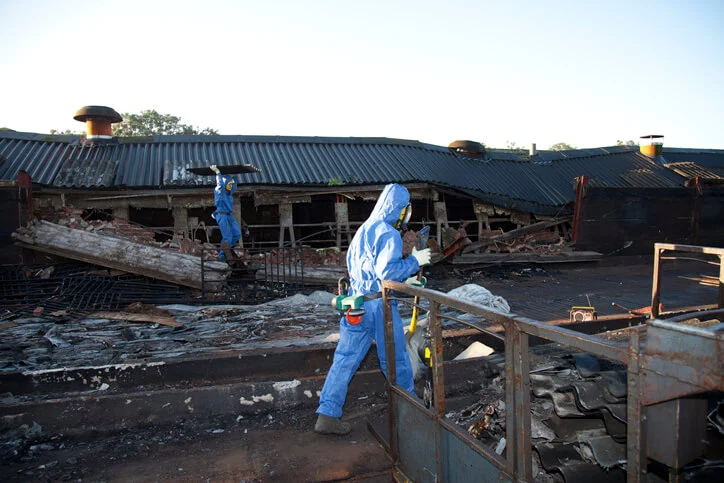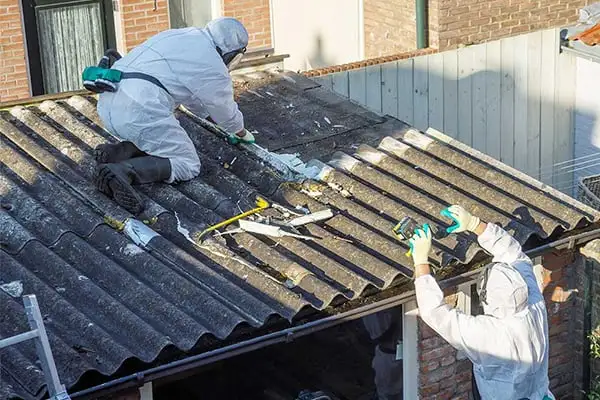Phone:
720-399-3335
Office address:
1685 S. Colorado Blvd. Suite 151, Denver, CO 80222

Exploring the delicate path of asbestos removal and disposal is a task we must approach with utmost care and adherence to proven protocols. We’ve got to remember that this isn’t just a simple clean-up job; it’s a matter of health and safety, where the smallest misstep could have significant consequences.
To execute this task correctly, we need to understand the risks, prepare meticulously, employ safe removal techniques, dispose of the material appropriately, and stay within the confines of legal regulations.
So, where do we start in mastering this complex process? And what are the key elements we mustn’t overlook?
Key Takeaways

Before we move ahead with the asbestos removal and disposal process, it’s important that we fully understand the risks associated with asbestos exposure. Asbestos, a mineral known for its heat resistance and durability, was widely used in the construction industry until the late 20th century. However, its history is tainted by the severe health implications it can cause when its microscopic fibers are inhaled.
The inhalation of asbestos fibers can lead to lung diseases such as asbestosis, lung cancer, and mesothelioma. Asbestosis is a chronic lung disease that causes shortness of breath, coughing, and permanent lung damage. Lung cancer, on the other hand, is a malignancy that originates in the lungs’ cells and can spread to other parts of the body. Mesothelioma is a rare form of cancer that develops in the lining of the lungs, heart, or abdomen, and it’s almost exclusively caused by asbestos exposure.
In light of these health risks, it’s clear why the removal and disposal of asbestos should be handled with utmost care. Understanding the dangers associated with asbestos exposure is a crucial step towards ensuring safe and effective asbestos removal and disposal. We can’t overemphasize the importance of this awareness.
To guarantee a safe and effective asbestos removal process, it’s essential that we meticulously prepare, beginning with assembling the right set of tools and protective equipment. We can’t overlook the importance of using items like respirators, coveralls, gloves, and goggles. These are necessary to shield against the inhalation of asbestos fibers, which can lead to serious health issues.
Beyond assembling our protective gear, the next step involves conducting a thorough site assessment. This means identifying and evaluating the areas where asbestos-containing materials (ACMs) are located. We’ll need to determine the condition of these ACMs, their potential for disturbance, and the extent of the contamination. It’s also paramount to note the type of asbestos present, as different types may require specific handling and disposal techniques.
In preparation, we’ll also secure the area, erecting warning signs and barriers. This is to prevent unauthorized access and limit potential exposure to bystanders. We’ll then establish a decontamination unit for safe removal of protective equipment post-task. Remember, preparation isn’t just about making the job easier; it’s about ensuring the safety of everyone involved. Now, we’re ready to discuss the actual removal techniques, but that’s a topic for our next section.

Having taken all necessary precautions, we’re now ready to investigate into the specifics of safe asbestos removal techniques, which are critical for preventing the release of harmful asbestos fibers into the air. Asbestos removal involves more than just pulling asbestos-containing materials (ACMs) out of a building. It’s a meticulous process that requires expertise, precision, and the right equipment to guarantee safety.
Here are four key aspects to take into account:
Incorporating these techniques, we can safely remove asbestos, reducing the risk of asbestos-related health issues.
Call Now
You Can Call Us At This Number: 720-399-3335
Once we’ve safely removed the asbestos, it’s equally important to dispose of it properly to prevent any danger to public health or the environment. This begins with a critical step: Disposal Site Selection. We must make certain the chosen site is officially authorized and equipped to handle hazardous waste like asbestos. It’s not just about dumping the material anywhere; it needs to be a controlled environment designed to prevent any asbestos fibers from escaping into the atmosphere.
Equally integral to the disposal process is the use of adequate Protective Equipment. We mustn’t overlook the importance of this safety measure. Even while disposing, asbestos particles can become airborne and pose a risk if inhaled. As such, we need to don appropriate gear such as respirators, coveralls, gloves, and boots. These are designed to prevent any direct contact with asbestos, safeguarding our health during the disposal process.
Once we’ve selected a suitable site and equipped ourselves properly, the asbestos waste should be double-bagged in thick, sturdy plastic bags. These bags should be tightly sealed and labeled accordingly. This ensures the safe transportation and disposal of asbestos, reducing the risk of exposure to the harmful fibers.
Exploring the maze of legal regulations and guidelines is an important part of the asbestos removal and disposal process. We must guarantee our practices are in line with these laws for the safety of all parties involved, and to maintain regulatory compliance.
Here are the four key elements of this process:
We’re committed to following these guidelines diligently. It’s not just about legality – it’s about ensuring the safety of our workers, clients, and the environment. With the right knowledge and commitment, we can navigate the complexities of asbestos legislation and regulatory compliance.
We’ve seen many health complications from prolonged asbestos exposure. Lung cancer, mesothelioma, and asbestosis are common asbestos exposure symptoms. These conditions often lead to asbestos-related lawsuits due to the negligence of safety standards.
We’ve found that it typically takes about 1-5 days to remove asbestos from a residential property. The duration largely depends on asbestos detection methods used and cost implications tied to the removal process.
We’re often asked if there are alternatives to asbestos in construction. Indeed, there are numerous non-asbestos building materials available. These asbestos substitute benefits include improved safety and equal, if not better, durability and insulation.
We’re firm believers in the importance of asbestos certification. It’s vital that professionals undergo rigorous training, including learning about the necessity of protective gear, to guarantee safe and effective asbestos removal.
Recycling asbestos? That’s a laugh! Seriously though, asbestos recycling methods aren’t widely used due to health risks. Asbestos reuse possibilities are limited and generally not recommended, it’s safer to dispose of it properly.
In wrapping up, we’ve navigated the treacherous terrain of asbestos removal and disposal.
It’s crystal clear, understanding the risks, preparing thoroughly, employing safe removal techniques, and adhering to legal guidelines isn’t just crucial, it’s lifesaving.
By following these protocols, we can guarantee asbestos becomes a ghost of the past, not a deadly specter looming over our future.
Remember, in this journey, knowledge and safety are our best companions.